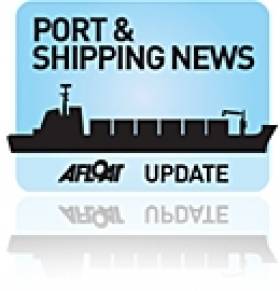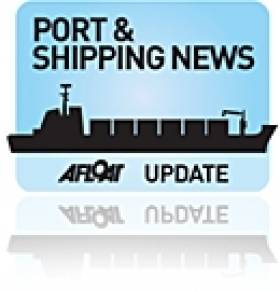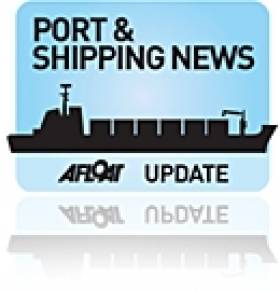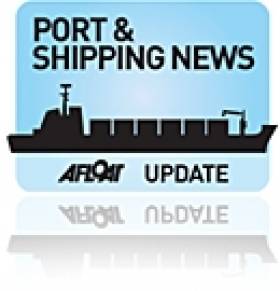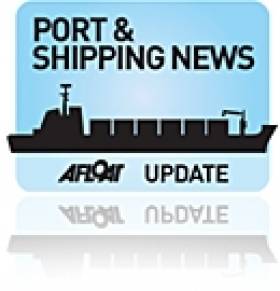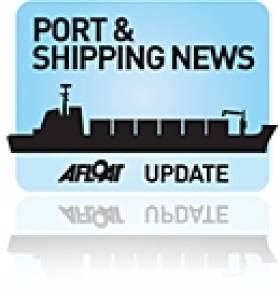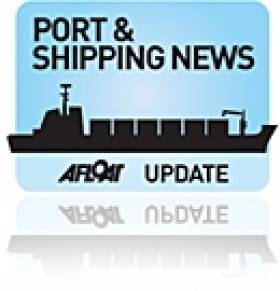Displaying items by tag: Port and Shipping News
Peel Ports Group Strengthens Irish Investment with IEA Membership
#Ports - Peel Ports Group, one of the UK and Ireland’s largest port groups, expressed its support for a growing Irish export market by becoming a member of the Irish Exporters Association (IEA), a group widely regarded as the voice of Ireland’s export industry.
Peel Ports currently operates at Belfast (Victoria Terminal) and Dublin (Marine Terminals Limited) handling 30% of all containers entering the island of Ireland. Between them the terminals handle around 300,000 units of TEU every year.
Membership to the IEA will not only open up access to a wide community of exporters and service providers in the Irish market, but will also allow Peel Ports to further develop its comprehensive range of transport connections across its Irish Sea network.
In addition it will allow Peel Ports' customers to grow global trade and increase exports from Ireland by providing access to a vital part of the supply chain infrastructure and bring added value to supply chains in terms of efficiency and cost effectiveness.
With strategic port locations in Liverpool, Manchester, Dublin, Belfast and Glasgow, Peel Ports provides what it describes as a 'unique Irish Sea Hub', further supported by its shipping line BG Freight Line.
Furthermore, it says, the hub allows shipping lines to reduce the cost of repositioning empty containers by rebalancing equipment across the network.
Some 82.5% of laden containers which arrive into the Irish Sea Hub also leave as laden containers, which are higher than the UK average of 54% - making transportation in and out of Ireland cheaper, according to Peel Ports.
Through a joined-up approach the Irish Sea Hub offers 'a one-stop solution' for container customers, allowing multiple port calls across the Irish Sea, reducing transportation costs to Ireland.
Peel Ports’ global connectivity will be further enhanced when its new £300 million Liverpool2 development opens for business at the Port of Liverpool in 2015.
Liverpool2 will be the UK’s most centrally located deep water container terminal, enabling direct services from around the world to call at Liverpool, making it a more efficient feeder hub for the Irish market.
Gerard Gaffney, head of container operations at Dublin and Belfast for Peel Ports Group, said: “We are an agile and progressive business and take a collaborative approach to working with our customers.
"We have tailored the services we offer across the Irish Sea hub to suit the market demand and are dedicated to service, consistency and growth.
“We look forward to working with the IEW in its worthwhile endeavours to support Irish exports in an improving economic climate, recognising the obvious benefits it will bring to Peel Ports Group and our customers.”
Meanwhile, IEA chief executive Simon McKeever said: “We are delighted to support Peel Ports Group and look forward to working with them as they continue to develop their activities across the Irish Sea.”
IMDO Shipping Review: EU Sulphur Directive in Maritime Industry,FTA Seek Postcode Reassurance,CEF Transport Calls on Proposals and much more
#Ports&Shipping –The latest IMDO Weekly Shipping Market Review includes the following stories as detailed below.
Irish Maritime Regulation: Directive 2012/33/ EU on Sulphur Emissions in the Maritime Industry- Air pollutant emissions from maritime transport can be transported over long distances and thus increasingly contribute to air quality problems in the EU.
The Thematic Strategy on air pollution from 2005 concluded that sulphur emissions from shipping were forecast to exceed those from all land-based sources in the EU by 2020. Further action is therefore needed to improve human health and the environment.
For latest responses to the Directive from three shipping companies, download the IMDO PDF below and for a copy of the Directive in the Irish Statute book, click HERE.
Irish Ports & Shipping News: FTA seeks reassurance over new postcodes - The Freight Transport Association of Ireland (FTAI) has sought reassurances that Eircode, Ireland's new postcode system, is fit for business. This follows concerns from members that the system appears optimized for the delivery of postal mail, but is not adequate for location or navigation purposes, or for the 'smart' economy. The post code will consist of seven-characters, including a routing key and an identifier unique to each mailing address. The system is designed to be a smart locater capable of identifying any address in the country and is hoped to be rolled out by 2015.
EU Funding: €11.93 billion allocation for 2014 CEF Transport Call - The 2014 CEF Transport Calls for Proposals, published on 11 September 2014, are the first calls under the successor programme to TEN-T.The main objective of CEF Transport is to help complete the TEN-T Core Network and its Corridors by 2030. A total budget of €26.2 billion has been allocated to co-fund TEN- T projects in the EU Member States for the period 2014-2020: more than three times the amount allocated to the predecessor TEN-T Programme (2007–2013).
For more on each of the above and other stories click the PDF downloadable IMDO Weekly Markets Review (Week 37). In addition to coverage on Afloat.ie's dedicated Ports & Shipping News section.
Container Giant CMA CGM Signs Three Major Trade Agreements
#ContainerAgreement– CMA CGM, the world's third largest shipping container operator, has announced the signature of three major agreements with China Shipping Container Lines (CSCL) and United Arab Shipping Company (UASC).
Under the name of 'Ocean Three,' they concern the Asia-Europe, Asia-Mediterranean, Transpacific and Asia-United States East Coast maritime trades.
The agreements (a combination of Vessel Sharing Agreements, Slot Exchange Agreements and Slot Charter Agreements) will complete the CMA CGM offering on the biggest global maritime markets, the French ocean shipping group said in a statement.
On the Asia-Europe trade, four weekly services will be offered , joining the two existing services, making a total of six departures per week
For more on this story, LloydsLoadingList.com has a report.
Ports & Shipping Review: EU Adopt Custom Plan, Cork of Port Hearing, Ireland-Spain Route Closed, Historic Cruise First for Waterford and much more
#Ports&ShippingReview: Over the last fortnight, Jehan Ashmore has reported on the shipping scene, where the EU adopts a plan to improve customs risk management.
A Port of Cork proposal for a €100m upgrade at Ringaskiddy for a container terminal is to be heard by An Bord Pleanala on 10 September.
Newbuild oil products tanker, Kestral Fisher the second of a pair of 7,072dwt vessels managed by UK based James Fisher Everard docked in Dublin Port.
LD Lines cease operating Ireland-Spain ro-ro ferry services. The 'landbridge' service via France was a historic first to link the nations when launched at the start of this year.
Irish Ferries part of the Irish Continental Group (ICG) release half-year financial report. Since the introduction of ro-pax Epsilon on Welsh and French ferry services, there has been substantial growth from both freight and tourism business.
An historic first for Waterford City Quays, as a record total of three cruiseships bringing more than 900 passengers and 500 crew visited the region.
Manx based Mezeron Freight Services 'classic' coaster cargoship, Silver River (1968/277grt) returned to the Irish Sea following a marine class survey in a Polish shipyard.
Arklow Beacon, the fourth of six 4,800dwt newbuild bulk cargoships, featuring a hull form with 'green' credentials is to be launched at a Dutch yard later this month.
Arklow's 'Green' Beacon to Be Launched This Month
#ArklowGreens- Arklow Shipping's fourth of six 4,800dwt newbuilds, Arklow Beacon featuring a 'green' credential designed hull is to be launched later this month in the Netherlands, writes Jehan Ashmore.
The 119m multi-purpose bulk orientated general cargoship like her sisters are built by Ferus Smit's Dutch yard at Westerbroek. Leadship Arklow Bank was launched earlier this year, she was followed by sisters also taking 'B' names, Arklow Bay and the latest to date in the series Arklow Beach which appeared in June.
The class have a hull form that was chosen to adapt the 'bulbless' principle creating a slender bow that dispenses the bulb. Taking into account the various loading drafts and wave conditions to be encountered in service, the total performance of this bow will be better than a bulb optimised for one single draft and flat water only.
Arklow Beacon will join the Irish company's Dutch subsidiary, Arklow Shipping Netherlands B.V. based in the Rotterdam.
The newbuilds classed with Bureau Veritas have a two-hold grain capacity of 9902,6m³ and for bale of 349.706ft³ . They will mainly be employed in the shipment of wheat, corn and other bulk commodities in European waters. Powerplant is a Mak engine delivering a maximum 13 knots.
Classic 60’s ‘Coaster’ Cargoship Returns to Manx Liner Services
#ManxShipping – Ramsey based Mezeron Freight Services coaster-general cargoship, Silver River (1968/277grt) returned to her Irish Sea 'liner' services in late August, following an extensive survey in a Polish shipyard, writes Jehan Ashmore.
As previously reported during a visit to the Isle of Man earlier this year, the single-ship operators of Silver River were able to confirm to Afloat.ie that she was undergoing a marine class survey work at the Morska Yard in Swinoujscie. On completion of the survey, her repositioning voyage from Poland last month involved an en route call to Falmouth for bunkers before arriving in home waters.
Silver River operates for the only Manx 'cargo' based shipping company which provides two liner routes. One of these is the Belfast-Ramsey service. At time of writing, Silver River is heading outward of Belfast Lough on a routine (Wednesdays) sailing as scheduled from Northern Ireland to the Isle of Man.
Tomorrow she discharges her cargo at the north-east Isle of Man port before loading again for the second liner service, that been Ramsey-Glasson Dock in Lancashire.
Among the cargo carried on board the Ramsey registered classic 1960's veteran 'coaster' is bagged cement, fertiliser and 20-ft (TEU) containers.
It is understood Silver River at almost 45m long is the last of the small old coaster-general cargoships operating a regular service within the boundaries of the Irish Sea. Her re-entry to service now nearing her 50th year is a testament to her German shipbuilders, Schiffswerft Schloemer in Moormerland. She was launched in 1968 as the Seacon.
The return of this rare breed of classic coaster will also be welcomed by followers of such ship port trade activity within Irish and UK waters.
In recognition of her Irish Sea coastal trading, the Isle of Man Post Office last year issued a special Manx Maritime Heritage Series Cover to celebrate the cargo company that has kept the island supplied for three decades since formation in 1983.
During her absence over several months, the larger 67m Isis (1978/674grt) was chartered from Great Glen Shipping based in Fort William, Scotland. Likewise of Silver River, she has a Manx registry of Douglas and is flagged under the UK's Red Ensign.
Following Silver River's return, the former Channel Islands serving Isis that once traded as David Doorman for Alderney Shipping, departed Ramsey for Pennyghael on the Isle of Mull.
Ports Shortlisted for ESPO's Societal Integration Port Award 2014
#PortAward2014 - The ports of Huelva, Koper, Lisbon, Marseille and Rotterdam have been shortlisted for the sixth European Sea Port Organisation (ESPO) Award on Societal Integration of Ports.
The jury yesterday selected these five applications from a total of twenty submissions. The theme of this year's competition as previously reported is 'Innovative environmental projects'.
Reducing the environmental impact of port operations and improving local environmental conditions for the people working and living around the port are key success factors for the societal integration of ports.
In fact, ports grant and maintain their license to operate and to grow from their local communities. Therefore, through the award, ESPO hopes to identify and promote innovative projects set up by ports that address the typical port-city concerns in the environmental field such as local air pollution, water pollution, noise, dust and odours.
"It has been very difficult to select five shortlisted projects. The five shortlisted ports prove to be concerned about the way they interact with their neighbours. These ports clearly demonstrate they respect the people who live close to them and carry responsibility towards the environment they work in," said jury chairman Dirk Sterckx.
The winner of the sixth ESPO Award will be announced during the Award Ceremony and Port Night taking place on 4 November in Brussels. The shortlisted projects will be presented on the ESPO website in the running up to this event.
The ESPO Award was established in 2009 to promote innovative projects of port authorities that improve societal integration of ports, especially with the city or wider community in which they are located.
In this way, the Award wants to stimulate the sustainable development of European ports and their cities.
ICG Release Mid-Year Financial Results
#ICGresults – Irish Continental Group (ICG) parent company of Irish Ferries, have released financial report results for the half-year ended 30 June 2014.
Results
The Board of Irish Continental Group plc (ICG) reports that, in the seasonally less profitable first half of the year, the Group recorded revenue of €130.7 million compared with €120.9 million in the same period in 2013, an increase of 8.1%.
Earnings before interest, tax, depreciation and amortisation (EBITDA) were €14.0 million compared with €15.8 million in the same period in 2013.
On a like-for-like basis i.e. excluding the newly introduced vessel 'Epsilon', EBITDA was up €1.2 million on the prior year.
Operating profit was €5.2 million compared with €6.4 million in 2013. Group fuel costs were up €2.5 million (10.5%) to €26.4 million, however when 'Epsilon' (€3.6 million) is excluded, fuel costs decreased by €1.1 million (4.6%) to €22.8 million.
There was a net finance charge of €2.5 million (2013: €3.1 million) which includes a net pension interest cost of €0.7 million (2013: €1.0 million) and net bank interest payable of €1.8 million (2013: €2.1 million).
Profit before tax was €2.7 million compared with €3.3 million in the first half of 2013. The tax charge amounted to €0.3 million (2013: €0.3 million).
Basic EPS was 1.3c compared with 1.6c* in the first half of 2013.
Adjusted EPS (before non-trading items and net pension interest cost) amounted to 1.7c (2013: 2.2c*).* As restated for the 10-for-1 share split (refer to note 2).
Commenting on the results, ICG Chairman John B. McGuckian stated; ''The introduction of the new RoRo ship 'Epsilon' on the Dublin-Holyhead and Dublin-Cherbourg routes has allowed us to grow both our freight and tourism businesses substantially during the year to date".
"I am particularly pleased with the growth in our RoRo freight business, up 20% in volume terms year to date (23 August 2014) while car volumes also remain strong - up 8% year to date (23 August 2014). The increases in both flows of business vindicate our decision to incur the necessary start-up costs in providing this much needed capacity.''
Epsilon: Strong revenue growth, up 8.1%, facilitated by the introduction of the new ro-ro vessel.
- 'Epsilon' drives volume growth in RoRo freight, up 18.5%
- Cars carried up 5.9% in the period
- Net Debt down to €71.9 million from €93.4 million at 31 December 2013
- Interim dividend 3.465 cent, up 5%
- Strong volume growth in summer, in both RoRo freight (up 25%) and cars (up 12%)
- Agreement reached with Pension Trustee on recovery plan
For further information showing all details of ICG's half-yearly financial report, click HERE.
IMDO Shipping Review: Irish Port Volumes 2% Rise, Container Oversupply, Finnlines Profit Boost, Strong VLCC Market and Much More
#Ports&Shipping –The latest IMDO Weekly Shipping Market Review includes the following stories as detailed below.
Irish Maritime Industry - Analysis released – As previously reported on Afloat.ie, Irish shipping and port activity rose by 2% in the second quarter of 2014 when compared to the corresponding period of 2013. The latest quarterly analysis according to iShipIndex also indicates that four of five principal freight segments grew in Q2 of 2014. For a more in-depth analysis click HERE.
Container Market: faces several more years of oversupply - AP Moller-Maersk chief executive Nils Andersen gave a broad ranging interview last week. He warned that Container operators four or five years of surplus capacity before demand catches up with supply is not as severe as some had feared, helped by better-than-expected volume growth in the Asia-Europe trades in recent months. But with an orderbook that still represents some 20% of existing capacity, it will take several years before the industry is back in equilibrium, Mr Andersen said in a telephone interview.
Short Sea Market: Finnlines Poised for Profit Boost as Rivals Suffer From EU Rules - Finnlines Oyj is geared to boost next year's profits as rivals stand to suffer under tighter environmental rules, while its modern ships will sail unhindered through the English Channel and Baltic Sea.
"This is a highly competitive business," Chief Financial Officer Tom Pippingskoeld said in an interview. "Considering our competitors with an older fleet, it may not be economical to install scrubbers on older vessels, since they are expensive. That may improve the market at the start of next year."
Tanker Market: Strong VLCC market looks set to continue - There is a positive outlook for an already strong VLCC spot market, analyst and broker sources have confirmed. DNB Securities' shipping analysts Nicolay Dyvik, Oyvind Berle and Petter Haugen cite a Reuters report, which said oil traders have started fixing crude tankers to bring North Sea, West African and Arab crude oil to South Africa for storage to repeat the super profits enjoyed in 2008-09.
For more of the above and other stories click here for PDF download of IMDO Weekly Markets Review (Week 35). In addition to Afloat.ie's dedicated Ports & Shipping News coverage.
Newbuild Oil Tanker: Kestral Fisher Follows King Sister
#TankerNewbuild- Newbuild oil products tanker, Kestral Fisher docked in Dublin Port today, she is the second of a pair of 7,072dwt vessels operated by James Fisher Everard of Barrow-In-Furness, Cumbria, writes Jehan Ashmore.
In June she entered service and her call to Dublin today sees her alongside No.1 Oil Berth, one of our such berths. It is understood she arrived from a Norwegian oil refinery at Slagen on the Oslofjord.
Likewise, her elder sister King Fisher (See Photo) as previously reported in March, are of the '8000' design launched from Damen Shipyards facility in Galati, Romania. They were outfitted in the Dutch group's Bergum yard in Harlingen.
Kestral Fisher was christened by Michelle Hartnup and was delivered to Dutch owners De Opfeart Beheer. Likewise she too is operated on an open management basis by James Fisher Everard.
Each of the 104m double-hulled 8,363m³ newbuilds have 10 epoxy coated-tanks. This will enable the newbuilds to carry gasoline, diesel oil, lubrication oil and jet fuels to ports and oil refineries throughout Ireland, the UK and north-western Europe.
They have accommodation for captain and ten-crew, plus a guest cabin, all of which are single and en-suite.





























